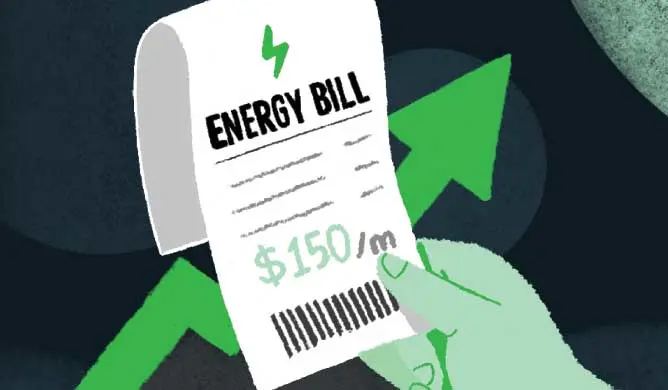Time to read : 4 Minutes
As Rising Bills Hurt Australian Households Switching To A Better Plan Is Recommended
The ACCC's latest Electricity Market Inquiry Report is out and it reveals that more Australians are experiencing the sting of rising residential electricity bills.
According to the report, electricity bills in Australian households were higher across most National Electricity Market states in the September quarter last year (2022) compared to the equivalent quarter in 2021.
And electricity bills are set to soar.
Why are electricity bills getting so high?
Blame the way record high wholesale prices from mid-2022 continue to flow through to customers. There is some small relief in the form of government rebates that came into play from 1 July this year. Eligible households will receive up to $500, with small businesses able to access up to $650.
And although wholesale electricity prices have eased since their mid-2022 peak, it's the lag that's currently hurting household budgets.
“We expect electricity bills to increase further this year due to the lag in wholesale costs flowing through to customers,” ACCC Commissioner Anna Brakey said.
“Energy retailers enter into supply contracts with generators years in advance to manage volatility, so households haven’t yet seen the full impact of last year’s wholesale price spikes.”
Retailer communications are being monitored by ACCC
A number of energy retailers recently announced increases to their market offer prices from 1 July, and some customers have already received price change notifications indicating significant increases. The ACCC has a careful eye on retailers’ price changes. It's all part of the watchdog's ongoing commitment to the electricity market inquiry and enforcement of the Electricity Retail Code.
“Any retailer that breaches the electricity code or seeks to mislead consumers about the reasons for electricity prices increasing can expect our attention," Ms Brakey warned.
Just this week, two retailers, CovaU and ReAmped Energy, each paid $33,300 in penalties. Their failing was to allegedly send communications to customers without including certain information required under the code.
Also this week, retailer Blue NRG agreed to compensate several business clients and provided a court-enforceable undertaking to the ACCC after it admitted making false or misleading representations by telling some customers on fixed-rate contracts that it had a legal right to raise electricity prices.
It didn't.
“The ACCC will continue to monitor retailer communications to ensure retailers are meeting their obligations. But more than ever, in the current environment of rising energy prices and cost of living pressures, it’s important for people to see if they can reduce their electricity bills by switching to a better plan,” Ms Brakey said.
Electricity prices across Australia
Pity South Australian households. Their 9.1 per cent increase in quarterly median electricity bills (between the September quarters of 2021 and 2022) was the highest of all National Electricity Market regions. Meanwhile, in New South Wales, residents saw a 6.4 per cent electricity bill rise. For Victorians, it was a comparatively low 0.6 per cent.
But in South-East Queensland, it went the other way. Households there saw a 20.4 per cent decrease in median residential bills in the September quarter 2022 - and all thanks to the Queensland Government’s $175 Cost of Living Rebate for Households applied to bills within that quarter.
Offers for new customers increase
As well as showing the prices customers pay in arrears through their quarterly bills, the report presents data on new offers available in the retail market.
Market offers are tailored plans that retailers make available to customers who shop around – and they're generally more competitive.
The report estimates the median annual bill for residential customers electing to take up a new market offer in March 2023, and then maintaining their electricity consumption, would climb 17 per cent above the figure for April 2022.
Choosing demand or time-of-use tariffs has the power to save money
The ACCC’s research reveals households that choose plans including demand or time-of-use tariffs were able to save money. But only if they're careful. For customers who make the switch to demand tariffs and then don't properly manage the time and intensity of their electricity usage end up being at greater risk of receiving higher bills.
When it comes to time-of-use tariffs, the savings can be there, but only for people who move their electricity consumption to cheaper times during the middle of the day or late at night - and that's not for everyone.
The report by the ACCC collected 13 million electricity bills to present its snapshot of billing outcomes faced by residential and small business electricity consumers across New South Wales, South Australia, South East Queensland, and Victoria. Western Australian and the Northern Territory are missing from the data because they're not connected to the National Electricity Market. And in the ACT, regional Queensland and Tasmania, many customers still have access to regulated retail electricity prices.
The next report is scheduled for December 2023.
The bottom line
The recommendation to explore and compare the offers from electricity retailers to find a better plan for your electricity bill is good advice.


































